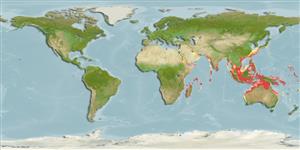Teleostei (teleosts) >
Tetraodontiformes (Puffers and filefishes) >
Triacanthidae (Triplespines)
Etymology: Pseudotriacanthus: Greek, pseudes = false + Greek, tres, tria = three + Greek, akantha = thorn (Ref. 45335).
Environment: milieu / climate zone / depth range / distribution range
Ecology
Marine; brackish; demersal; depth range 2 - 110 m (Ref. 3540). Tropical
Indo-Pacific: Persian Gulf, Gulf of Oman, Arabian Sea, Bay of Bengal, Philippines, South China Sea including Gulf of Thailand, Indonesia, and northern Australia.
Size / Weight / Age
Maturity: Lm ? range ? - ? cm
Max length : 25.0 cm TL male/unsexed; (Ref. 9804); common length : 20.0 cm TL male/unsexed; (Ref. 3540)
Second dorsal-fin spine more than 1/2 length of first dorsal-fin spine. Anal-fin base about 2 times in soft dorsal-fin base. Scales with an anterior to posterior series of high, thin, distally emarginated vertical ridges (Ref 9804).
Occurs in coastal and estuarine waters, on sandy or muddy flats to depths of usually 60 m, Ref. 48637. Feeds on benthic invertebrates. Sold fresh in markets.
Life cycle and mating behavior
Maturities | Reproduction | Spawnings | Egg(s) | Fecundities | Larvae
Matsuura, K., 2001. Triacanthidae. Triplespines. p. 3905-3910. In K.E. Carpenter and V. Niem (eds.) FAO species identification guide for fishery purposes. The living marine resources of the Western Central Pacific. Vol. 6. Bony fishes part 4 (Labridae to Latimeriidae), estuarine crocodiles. FAO, Rome. (Ref. 9804)
IUCN Red List Status (Ref. 130435)
Threat to humans
Harmless
Human uses
Fisheries: minor commercial; aquarium: commercial
Tools
Special reports
Download XML
Internet sources
Estimates based on models
Preferred temperature (Ref.
123201): 24.7 - 29, mean 28 °C (based on 1840 cells).
Phylogenetic diversity index (Ref.
82804): PD
50 = 1.0078 [Uniqueness, from 0.5 = low to 2.0 = high].
Bayesian length-weight: a=0.01259 (0.00697 - 0.02274), b=2.88 (2.72 - 3.04), in cm total length, based on LWR estimates for this species & (Sub)family-body (Ref.
93245).
Trophic level (Ref.
69278): 2.5 ±0.20 se; based on food items.
Resilience (Ref.
120179): Medium, minimum population doubling time 1.4 - 4.4 years (Preliminary K or Fecundity.).
Fishing Vulnerability (Ref.
59153): Low vulnerability (15 of 100).
